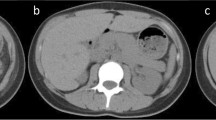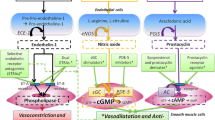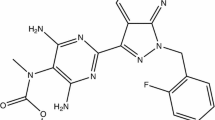Abstract
Introduction
Epoprostenol, a synthetic prostaglandin I2 (PGI2) analog, has been the mainstay of treatment for severe pulmonary arterial hypertension (PAH) for the last two decades. Treprostinil, another synthetic prostaglandin analog, and selexipag, an oral selective Inositol Phosphate (IP) prostacyclin receptor agonist, have also been approved for treatment of PAH. Prostacyclin and its analogs cause a variety of side effects in patients with PAH; however, thyroid dysfunction is rarely reported.
Methods
After treating an index case of thyroid dysfunction occurring after initiation of epoprostenol, we reviewed our databases of PAH patients treated with epoprostenol, treprostinil or selexipag to identify the occurrence of this association.
Results
We identified six cases of thyroid dysfunction in our cohort: five after initiation of an intravenous prostacyclin (epoprostenol) and one after initiation of an oral prostacyclin receptor agonist (selexipag). Four of the patients presented with hyperthyroidism and two with a large autoimmune goiter. Graves’ disease was seen in three patients, Hashimoto’s disease in two patients and thyrotoxicosis in one patient.
Conclusion
Therapy with medications targeting the prostacyclin pathway is a potential risk factor for the development of symptomatic thyroid disease.

Similar content being viewed by others
References
Galiè N, Humbert M, Vachiery JL et al (2016) 2015 ESC/ERS guidelines for the diagnosis and treatment of pulmonary hypertension: the Joint Task Force for the Diagnosis and Treatment of Pulmonary Hypertension of the European Society of Cardiology (ESC) and the European Respiratory Society (ERS): endorsed by: Association for European Paediatric and Congenital Cardiology (AEPC), International Society for Heart and Lung Transplantation (ISHLT). Eur Heart J 37(1):67–119
Badesch DB, Raskob GE, Elliott CG et al (2010) Pulmonary arterial hypertension: baseline characteristics from the REVEAL Registry. Chest 137(2):376–387
Curnock AL, Dweik RD, Higgins BH, Saadi HF, Arroliga AC (1999) High prevalence of hypothyroidism in patients with primary pulmonary hypertension. Am J Med Sci 318(5):289–292
Arroliga AC, Dweik RA, Rafanan AL (2000) Primary pulmonary hypertension and thyroid disease. Chest 118(4):1224–1225
Kashyap AS, Kashyap S (2001) Thyroid disease and primary pulmonary hypertension. JAMA 285(22):2853–2854
Marvisi M, Brianti M, Marani G, Del Borello P, Bortesi ML, Guariglia A (2002) Hyperthyroidism and pulmonary hypertension. Respir Med 96(4):215–220
Chu JW, Kao PN, Faul JL, Doyle RL (2002) High prevalence of autoimmune thyroid disease in pulmonary arterial hypertension. Chest 122(5):1668–1673
Iervasi G, Molinaro S, Landi P et al (2007) Association between increased mortality and mild thyroid dysfunction in cardiac patients. Arch Intern Med 167(14):1526–1532
Iervasi G, Pingitore A, Landi P et al (2003) Low-T3 syndrome: a strong prognostic predictor of death in patients with heart disease. Circulation 107(5):708–713
Miura Y, Fukumoto Y, Sugimura K et al (2010) Identification of new prognostic factors of pulmonary hypertension. Circ J 74(9):1965–1971
Vallabhajosula S, Radhi S, Alalawi R, Raj R, Nugent K, Cevik C (2011) Hyperthyroidism and pulmonary hypertension: an important association. Am J Med Sci 342(6):507–512
Macchia A, Marchioli R, Tognoni G, Scarano M, Marfisi R, Tavazzi L, Rich S (2010) Systematic review of trials using vasodilators in pulmonary arterial hypertension: why a new approach is needed. Am Heart J 159(2):245–257
Humbert M, Ghofrani HA (2016) The molecular targets of approved treatments for pulmonary arterial hypertension. Thorax 71(1):73–83
Rubin LJ, Mendoza J, Hood M et al (1990) Treatment of primary pulmonary hypertension with continuous intravenous prostacyclin (epoprostenol): results of a randomized trial. Ann Intern Med 112(7):485–491
Coeytaux RR, Schmit KM, Kraft BD et al (2014) Comparative effectiveness and safety of drug therapy for pulmonary arterial hypertension: a systematic review and meta-analysis. Chest 145(5):1055–1063
Barst RJ, Rubin LJ, McGoon MD, Caldwell EJ, Long WA, Levy PS (1994) Survival in primary pulmonary hypertension with long-term continuous intravenous prostacyclin. Ann Intern Med 121(6):409–415
McLaughlin VV, Shillington A, Rich S (2002) Survival in primary pulmonary hypertension: the impact of epoprostenol therapy. Circulation 106(12):1477–1482
Barst RJ, Rubin LJ, Long WA et al (1996) A comparison of continuous intravenous epoprostenol (prostacyclin) with conventional therapy for primary pulmonary hypertension. N Engl J Med 334(5):296–301
Badesch DB, Tapson VF, McGoon MD et al (2000) Continuous intravenous epoprostenol for pulmonary hypertension due to the scleroderma spectrum of disease: a randomized, controlled trial. Ann Intern Med 132(6):425–434
Kuhn KP, Byrne DW, Arbogast PG, Doyle TP, Loyd JE, Robbins IM (2003) Outcome in 91 consecutive patients with pulmonary arterial hypertension receiving epoprostenol. Am J Respir Crit Care Med 167(4):580–586
Sitbon O, Channick R, Chin KM et al (2015) Selexipag for the treatment of pulmonary arterial hypertension. N Engl J Med 373(26):2522–2533
Ferris A, Jacobs T, Widlitz AB, Robyn J, Morse JH (2001) Pulmonary arterial hypertension and thyroid disease. Chest 119(6):1980
Davies A, Frost A (1997) Epoprostenol-associated thyropathy in PPH patients [abstract]. Am J Respir Crit Care Med 155(suppl):A630
Gu Y, Schwarcz MD, Weiss IA (2016) Pulmonary hypertension aggravated by hyperthyroidism: a case report [abstract]. Endocr Rev 37(2):Supplement 1
Nakchbandi IA, Wirth JA, Inzucchi SE (1999) Pulmonary hypertension caused by Graves’ thyrotoxicosis: normal pulmonary hemodynamics restored by 131I treatment. Chest 116(5):1483–1485
Marvisi M, Balzarini L, Mancini C, Mouzakiti P (2013) Thyroid gland and pulmonary hypertension. What’s the link? Panminerva Med 55(1):93–97
Castillo MP, García FH, Montero PB, González RL, Ocaña CM, Sánchez JR (2009) Thyroid dysfunction in patients with pulmonary arterial hypertension. A cohort study of 58 patients. Med Clin (Barc) 132(18):695–700
Srimatkandada P, Farber HW, Coviello AD (2014) Rapid development of compressive goiter and severe hyperthyroidism in a patient with pulmonary arterial hypertension after treatment with epoprostenol [abstract]. Endocr Rev 35(3)
Srimatkandada P, Coviello AD (2015) Severe autoimmune hyperthyroidism in two patients with pulmonary arterial hypertension after treatment with epoprostenol. J Thyroid Disord Ther. 4(176):2
Funasako M, Miyaji K, Sakuma M, Takagi Y, Kyotani S, Nakanishi N (2010) Long-term epoprostenol infusion therapy could induce hyperthyroidism in patients with idiopathic and hereditary pulmonary arterial hypertension [abstract]. Circulation 122(21_MeetingAbstracts):Supplement 1
Galie N, Rubin LJ, Hoeper MM et al (2008) Treatment of patients with mildly symptomatic pulmonary arterial hypertension with bosentan (EARLY study): a double-blind, randomised controlled trial. Lancet 371(9630):2093–2100
Galiè N, Olschewski H, Oudiz RJ et al (2008) Ambrisentan in Pulmonary Arterial Hypertension, Randomized, Double-Blind, Placebo-Controlled, Multicenter, Efficacy Studies (ARIES) Group. Ambrisentan for the treatment of pulmonary arterial hypertension: results of the ambrisentan in pulmonary arterial hypertension, randomized, double-blind, placebo-controlled, multicenter, efficacy (ARIES) study 1 and 2. Circulation 117(23):3010–3019
Rubin LJ, Badesch DB, Fleming TR et al (2011) Long-term treatment with sildenafil citrate in pulmonary arterial hypertension: the SUPER-2 study. Chest 140(5):1274–1283
Zor U, Kaneko T, Lowe IP, Bloom G, Field JB (1969) Effect of thyroid-stimulating hormone and prostaglandins on thyroid adenyl cyclase activation and cyclic adenosine 3′, 5′-monophosphate. J Biol Chem 244(19):5189–5195
Virgolini I, Steurer G, Keminger K, Sinzinger H, Kraupp O (1987) Evaluation of prostaglandin receptors in the human thyroid gland. Prog Clin Biol Res 242:35–42
Kasai K, Hiraiwa M, Suzuki Y et al (1986) Prostacyclin stimulation of adenylate cyclase activity in human thyroid membranes. Horm Metab Res 18(09):625–629
Chadha C, Pritzker M, Mariash C (2009) Effect of epoprostenol on the thyroid gland: enlargement and secretion of thyroid hormone. Endocr Pract 15(2):116–121
Satoh M, Aso K, Nakayama T, Saji T (2017) Effect of treatment with epoprostenol and endothelin receptor antagonists on the development of thyrotoxicosis in patients with pulmonary arterial hypertension. Endocr J 64(12):1173–1180
Virgolini I, Hermann M, Sinzinger H (1989) Decrease of the prostaglandin I2 binding capacity in thyroids from patients with Graves’ disease. Prostaglandins Leukot Essent Fatty Acids 37(2):121–128
Yoh-ichiro K, Kanemaru Y, Noguchi T, Onaya T (1987) Circulating prostacyclin and thromboxane in patients with Graves’ disease. Prostaglandins Leukot Essent Fatty Acids 26(1):75–84
Brix TH, Hegedüs L (2011) The complexity of the etiology of autoimmune thyroid disease is gravely underestimated. Thyroid 21(12):1289–1292
Frey A, Kroiss M, Berliner D et al (2013) Prognostic impact of subclinical thyroid dysfunction in heart failure. Int J Cardiol 168:300–305
Author information
Authors and Affiliations
Contributions
AAM, SS, and HWF were involved in the study design, data collection (including figures), data interpretation, and literature review; all authors contributed to the writing and revision of the manuscript. AAM, SS, and HWF are the guarantors of and take responsibility for the content of the manuscript.
Corresponding author
Ethics declarations
Conflict of interest
AA.M and L.E.B have no conflicts of interest to disclose. S.S has received consultant fees from Actelion Pharmaceuticals and speaker fees from Actelion Pharmaceuticals, Bayer AG and United Therapeutics Corporation. H.W.F. has received research grants from Gilead; Actelion Pharmaceuticals US Inc; and United Therapeutics Corporation and consulting fees from Gilead; Actelion Pharmaceuticals US, Inc; United Therapeutics Corporation; Bayer AG; Arena, Boehringer-Ingelheim; and Bellerophon. He also has served on a speaker’s bureau or given presentations on behalf of Actelion Pharmaceuticals US, Inc; Gilead; and Bayer AG.
Additional information
Publisher's Note
Springer Nature remains neutral with regard to jurisdictional claims in published maps and institutional affiliations.
Rights and permissions
About this article
Cite this article
Menon, A.A., Sahay, S., Braverman, L.E. et al. Thyroid Dysfunction in Patients with Pulmonary Artery Hypertension (PAH): The Effect of Therapies Affecting the Prostanoid Pathway. Lung 197, 761–768 (2019). https://doi.org/10.1007/s00408-019-00283-8
Received:
Accepted:
Published:
Issue Date:
DOI: https://doi.org/10.1007/s00408-019-00283-8




